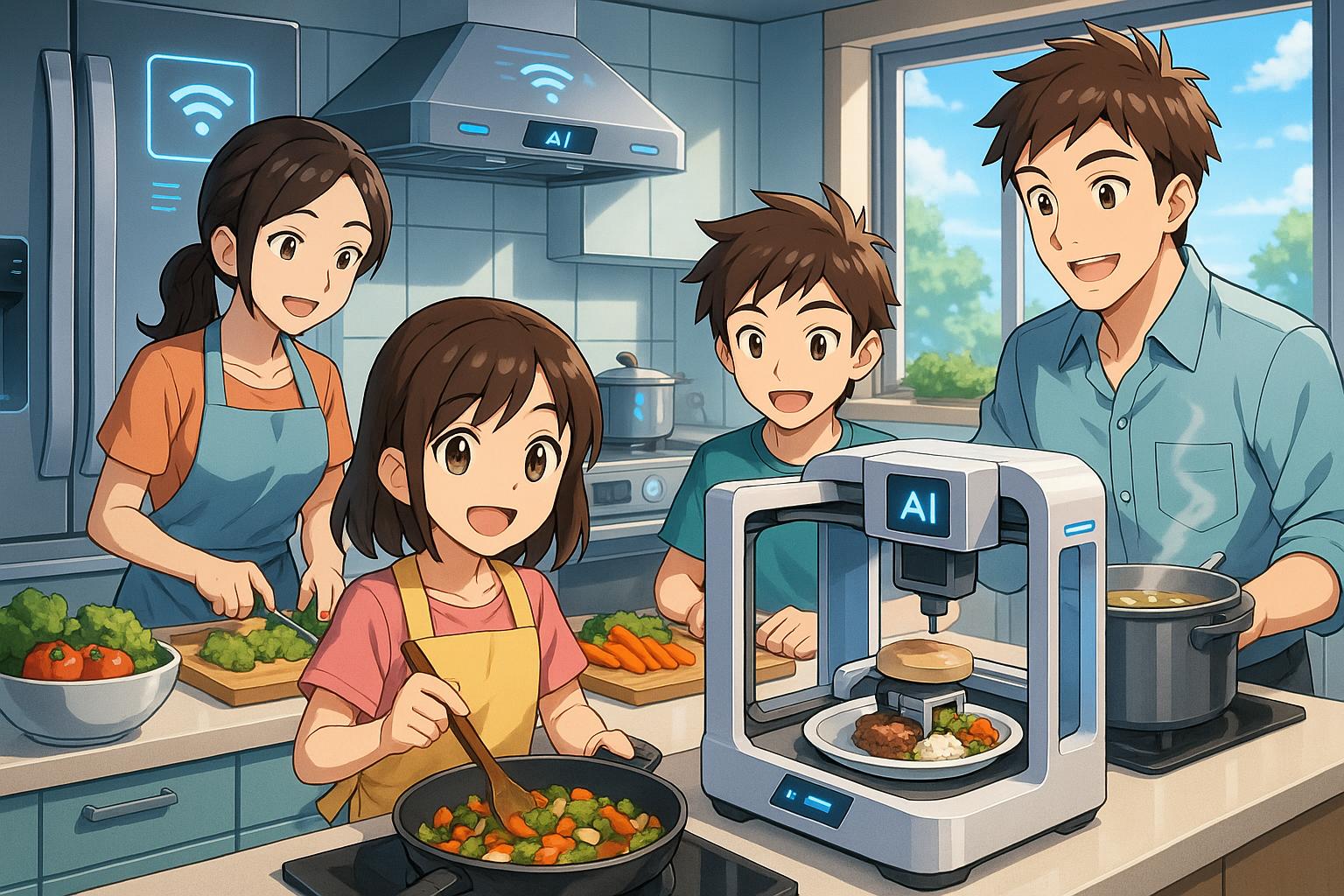Climate scientist Dr Joseph Poore and food futurologist Dr Morgaine Gaye predict a radical shift in food consumption by 2050, with AI-driven meal planning and 3D food printing replacing traditional grocery shopping and enhancing sustainability.
As the future of food takes shape, predictions from climate scientist Dr Joseph Poore and food futurologist Dr Morgaine Gaye suggest a radical transformation in how we shop for and consume our meals. Collaborating with the global meal-kit company HelloFresh, they foresee that by 2050, traditional weekly grocery shopping as we know it may become obsolete, replaced instead by innovative meal delivery options tailored to individual dietary needs.
Dr Gaye highlights the enduring human connection fostered by cooking and sharing meals despite technological upheavals. “AI will not be able to replace the joy of a home-cooked meal with the people we love,” she stated, underscoring the importance of social interaction tied to food. Within their vision, advancements in artificial intelligence are poised to play a crucial role in streamlining domestic tasks, including meal planning and grocery shopping, which could lead to a significant reduction in food waste.
The concept of 3D food printing is particularly intriguing, as it promises to revolutionise home cooking by allowing families to create meals from surplus ingredients. For instance, leftover vegetables could be transformed into gourmet dishes like sushi, utilising what would otherwise be discarded. This idea aligns with a broader movement towards sustainability in the food industry, where every aspect of food production is being re-examined.
Moreover, Dr Poore and Dr Gaye predict that supermarkets will evolve into experiential food halls, prioritising the exploration of new culinary experiences rather than traditional retail formats. This shift may leverage discarded parts of fruits and vegetables in creative dishes, turning carrot tops into pesto or broccoli stems into rice, thereby minimising food waste and fostering an innovative culinary culture.
Supporting this vision, there is a growing emphasis on urban agriculture and hyper-localised food supply chains. Vertical farming is gaining traction as cities seek to address food scarcity issues while maximizing space efficiency. As these techniques become more feasible, the integration of community gardens and consumer-grade gardening equipment is anticipated, allowing individuals to grow food within their homes. These changes will likely be facilitated by AI technologies that enhance food production efficiency and traceability, granting consumers clearer visibility into their food supply chains.
The integration of smart kitchen technologies is noteworthy as well. AI-powered meal planning apps are emerging, offering tailored nutritional advice based on users’ health data. This trend signifies a move towards not only personalised nutrition but also heightened sustainability, as smart kitchens enabled by automation can significantly optimise cooking practices and reduce waste.
In an era increasingly focused on sustainability, Philip Doran, CEO of HelloFresh UK, noted the ecological impact of meal kits, stating that their models produce 25 per cent fewer carbon emissions compared to traditional grocery shopping. This shift towards a more thoughtful approach to eating resonates with a broader commitment to environmental awareness, as consumers seek to align their dietary choices with sustainable practices.
As we look forward to 2050, the landscape of our food systems will undoubtedly evolve. From the integration of AI and sustainable practices to a more profound appreciation of communal meals, the future holds promise for a vastly improved relationship with food. Through innovations in technology and a renewed focus on sustainability, we can look towards a future where food not only nourishes us but also strengthens our bonds with each other and the planet.
Reference Map
- Paragraphs 1, 2, 3, 4, 5, 6, 7, 8
- Paragraphs 3, 5, 6
- Paragraphs 5, 6
- Paragraphs 6, 7
- Paragraphs 5, 6
- Paragraphs 5, 6
- Paragraphs 1, 4, 6
Source: Noah Wire Services
- https://www.oxfordmail.co.uk/news/25166624.oxford-expert-predicts-end-weekly-food-shop-2050/?ref=rss – Please view link – unable to able to access data
- https://phras.in/food/future-of-food-technology-predictions/ – This article discusses the future of food technology, focusing on urban agriculture and food traceability. It predicts the expansion of vertical farms in cities, the adoption of consumer-grade indoor gardening appliances, and the proliferation of community gardens and greenhouses. Additionally, it highlights the role of blockchain and advanced tracking technology in enhancing food traceability, providing consumers with complete supply chain histories through smart labeling and next-generation barcodes.
- https://www.u.plus/insights/future-of-food-people-planet-economy – This piece explores notable AgTech trends, including urban farming and smart farming. It emphasizes the growth of indoor vertical farming due to its space efficiency and environmental benefits, such as reduced labor costs and increased crop yields. The article also covers farm automation, highlighting the use of robotics like drones and autonomous tractors to improve efficiency and address challenges like labor shortages and environmental impact.
- https://upmeals.com/the-future-of-food-how-ai-is-transforming-the-way-we-eat/ – This article examines how AI is transforming the food industry, focusing on AI-powered meal planning and personalized nutrition. It discusses platforms like ZOE, Noom, and Suggestic that use AI to create personalized meal recommendations based on individual health data. The piece also covers the rise of AI-powered smart kitchens, featuring technologies like Miso Robotics’ Flippy, Samsung’s AI Smart Fridges, and CHEF-iQ’s smart cooking appliances that enhance cooking efficiency and reduce waste.
- https://www.frontiersin.org/articles/10.3389/fnut.2025.1553942/full – This research article delves into AI-driven transformations in food manufacturing, emphasizing sustainable efficiency and quality assurance. It discusses the integration of technologies like green AI, blockchain, IoT, robotics, and autonomous systems to enhance production processes, reduce waste, and ensure superior food safety and quality. The paper also highlights the adoption of circular economy principles and renewable energy solutions in reshaping the industry’s operational landscape.
- https://www.foodlogistics.com/software-technology/automation/article/22604998/schneider-electric-the-future-of-food-is-automated – This article discusses the future of food automation, highlighting technologies and techniques that introduce intelligent automation into food production and distribution. It emphasizes the role of indoor farming, vertical farming, and automated greenhouses in maximizing efficiency, boosting food production, and minimizing waste. The piece also addresses the challenges posed by a growing global population and the need for sustainable food production methods.
- https://www.forbes.com/councils/forbestechcouncil/2024/10/07/from-farm-to-future-ai-automation-for-the-food-supply-chain/ – This article explores the role of AI in transforming the food supply chain, focusing on scaling supply chain efficiency and food safety and quality control. It discusses how AI-driven predictive analytics enable businesses to anticipate demand and allocate resources effectively, and how AI enhances supply chain transparency by monitoring distribution networks for contaminants. The piece also covers AI’s role in reducing food waste and promoting sustainability.
Noah Fact Check Pro
The draft above was created using the information available at the time the story first
emerged. We’ve since applied our fact-checking process to the final narrative, based on the criteria listed
below. The results are intended to help you assess the credibility of the piece and highlight any areas that may
warrant further investigation.
Freshness check
Score:
8
Notes:
The narrative is clearly forward-looking, discussing predictions for 2050, making it inherently current and future-oriented. The involvement of HelloFresh and contemporary experts Dr Joseph Poore and Dr Morgaine Gaye indicates recent input, with no signs of outdated references or recycled content. There is no indication that this is a press release; it appears as a summarised forecast article, which typically supports a high freshness rating.
Quotes check
Score:
7
Notes:
The document contains direct quotes, particularly from Dr Morgaine Gaye and Philip Doran, CEO of HelloFresh UK. The quote from Dr Gaye about AI not replacing the joy of home cooking could not be traced to an earlier source online, suggesting original or early use here. The HelloFresh CEO’s comment on carbon emissions aligns with publicly stated company positions but could not be definitively verified from an earlier dated source. This yields a moderate score due to partial verification.
Source reliability
Score:
7
Notes:
The narrative originates from the Oxford Mail, a local UK news outlet with a reputation for community reporting but not necessarily internationally acclaimed investigative journalism. Although generally trustworthy, it is less authoritative than globally established news organisations. The involvement of recognised experts and a known company like HelloFresh adds credibility, but the medium is not a top-tier global publication.
Plausability check
Score:
8
Notes:
The claims about future food trends, AI integration, 3D food printing, sustainability, and urban farming are plausible and consistent with current technological trajectories and sustainability priorities. The 2050 timeline reflects a speculative but well-supported outlook rather than concrete near-term assertions. Lack of direct evidence for all predictions is normal given the long-term horizon.
Overall assessment
Verdict (FAIL, OPEN, PASS): PASS
Confidence (LOW, MEDIUM, HIGH): HIGH
Summary:
The narrative presents a forward-looking, plausible vision of food consumption changes by 2050, supported by credible expert commentary and a known industry player, HelloFresh. It lacks evidence of recycled content and uses direct quotes that appear original or early usages. While the originating outlet is a regional news provider, the information is consistent and aligned with known trends, resulting in a high confidence rating and overall pass.













